The Expanding Role of the Auditor in CSR and Sustainability Reporting
VerifiedAdded on 2023/01/23
|11
|2442
|91
Report
AI Summary
This report, titled 'THE EXPANDING ROLE OF THE AUDITOR,' provides a comprehensive analysis of Corporate Social Responsibility (CSR) and sustainability reporting. It defines and differentiates between CSR and sustainability, highlighting their similarities and discussing the historical evolution of sustainability reporting and assurance. The report identifies companies engaged in such reporting and explores future trends, including climate change, human rights, and wealth inequality. It references relevant frameworks like those from the European Union and provides guidelines for auditors using the International Framework for Assurance Engagements. The report concludes by emphasizing the importance of non-financial reporting and the role of auditors in ensuring its accuracy and impact.
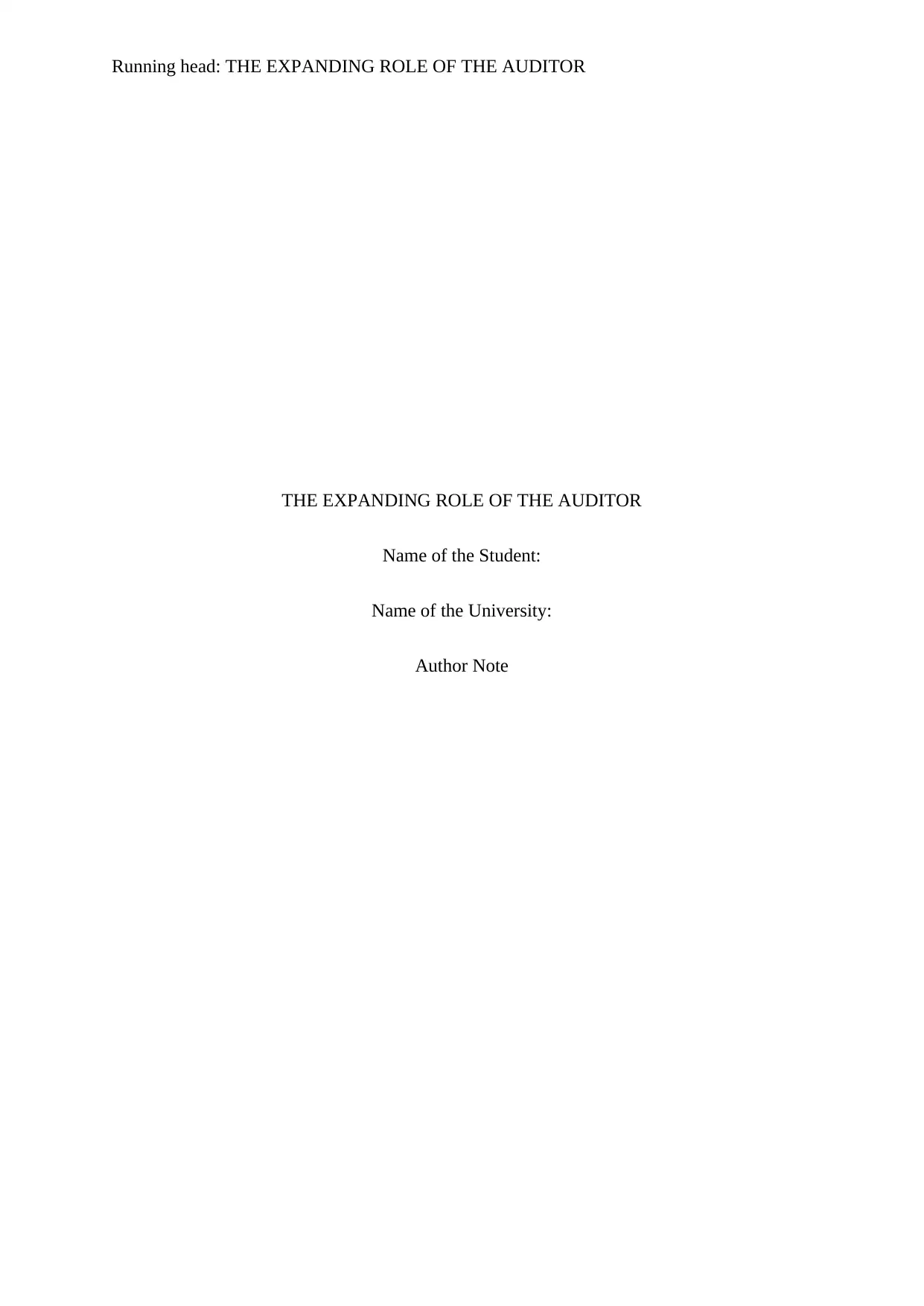
Running head: THE EXPANDING ROLE OF THE AUDITOR
THE EXPANDING ROLE OF THE AUDITOR
Name of the Student:
Name of the University:
Author Note
THE EXPANDING ROLE OF THE AUDITOR
Name of the Student:
Name of the University:
Author Note
Paraphrase This Document
Need a fresh take? Get an instant paraphrase of this document with our AI Paraphraser
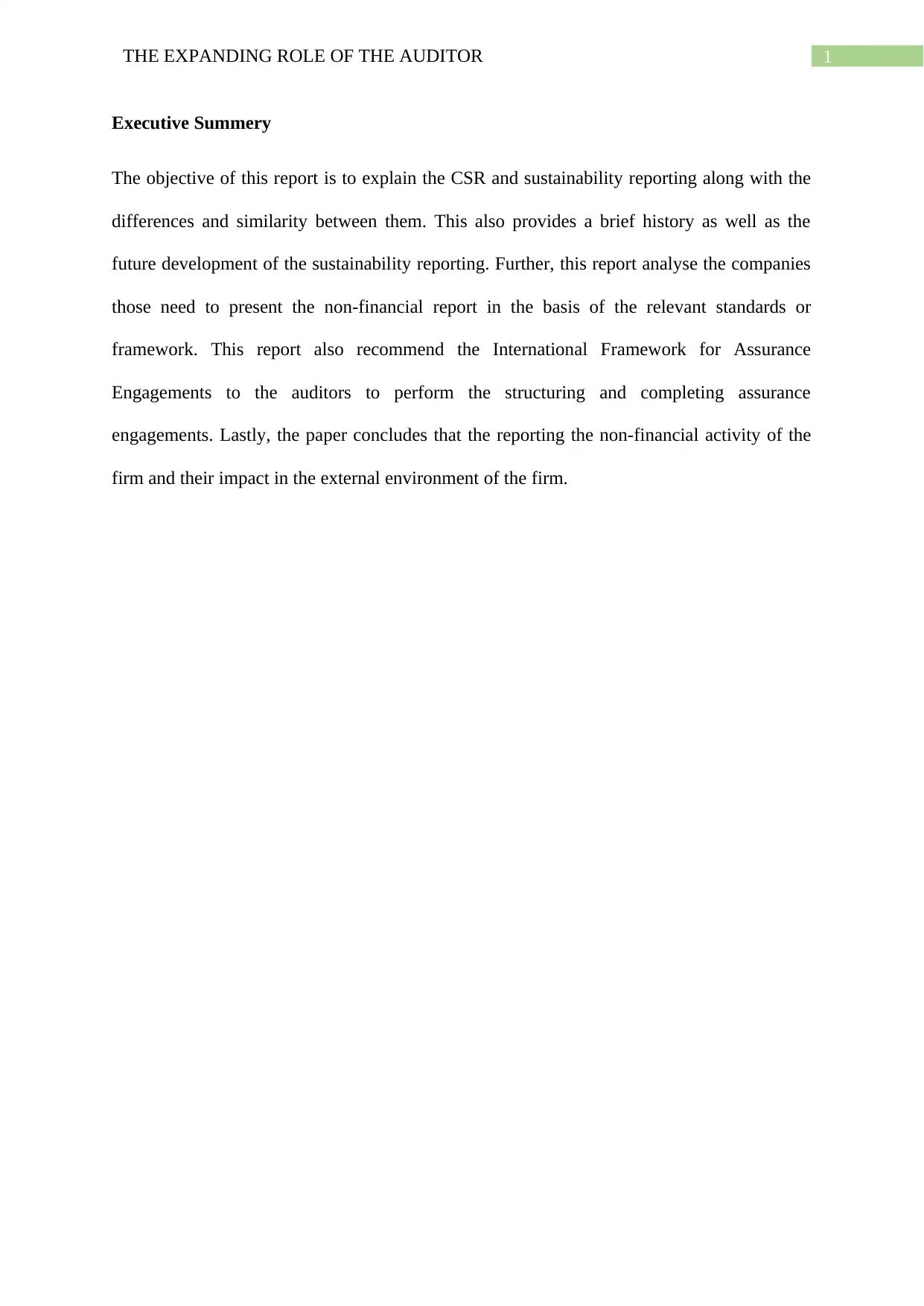
1THE EXPANDING ROLE OF THE AUDITOR
Executive Summery
The objective of this report is to explain the CSR and sustainability reporting along with the
differences and similarity between them. This also provides a brief history as well as the
future development of the sustainability reporting. Further, this report analyse the companies
those need to present the non-financial report in the basis of the relevant standards or
framework. This report also recommend the International Framework for Assurance
Engagements to the auditors to perform the structuring and completing assurance
engagements. Lastly, the paper concludes that the reporting the non-financial activity of the
firm and their impact in the external environment of the firm.
Executive Summery
The objective of this report is to explain the CSR and sustainability reporting along with the
differences and similarity between them. This also provides a brief history as well as the
future development of the sustainability reporting. Further, this report analyse the companies
those need to present the non-financial report in the basis of the relevant standards or
framework. This report also recommend the International Framework for Assurance
Engagements to the auditors to perform the structuring and completing assurance
engagements. Lastly, the paper concludes that the reporting the non-financial activity of the
firm and their impact in the external environment of the firm.
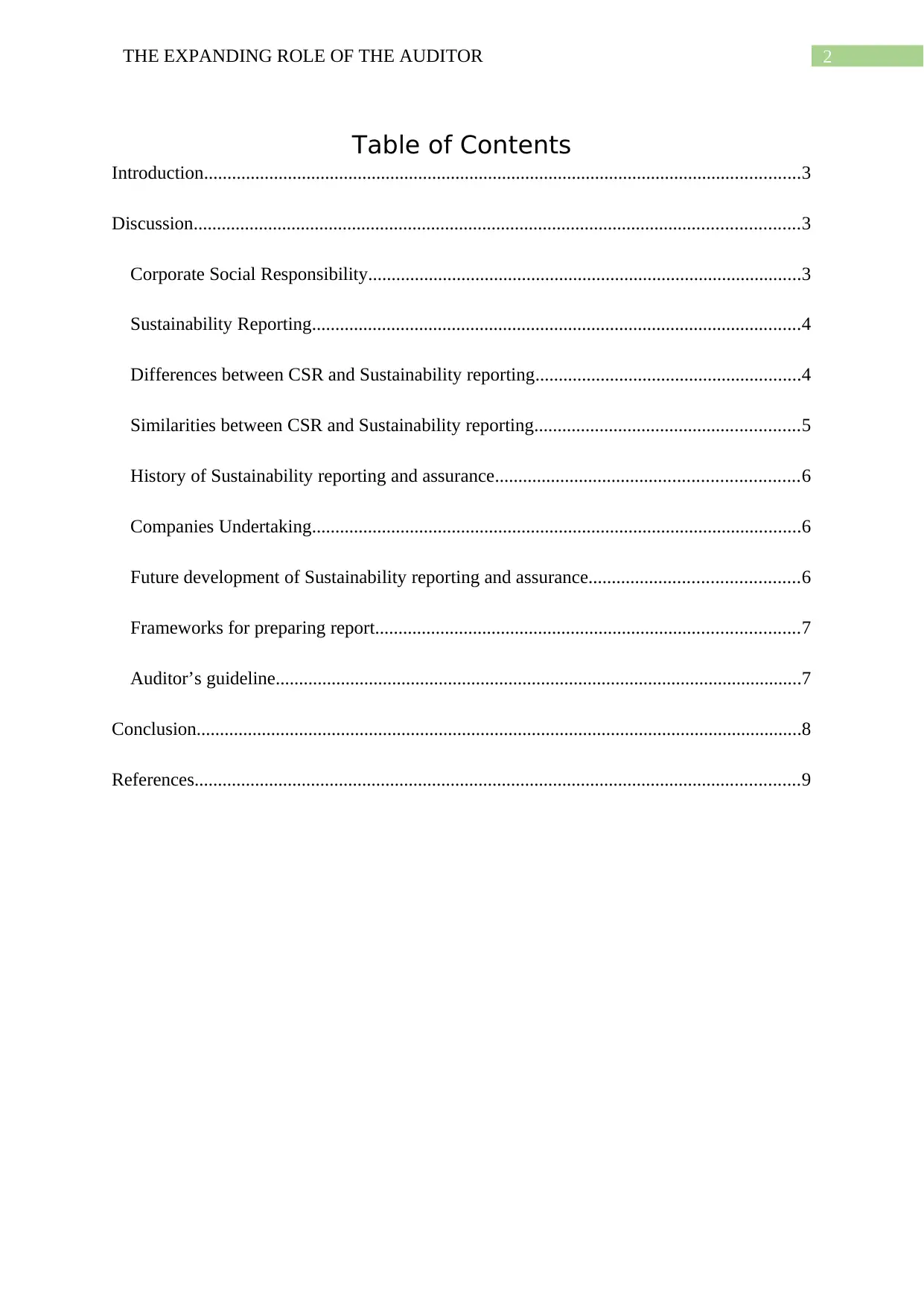
2THE EXPANDING ROLE OF THE AUDITOR
Table of Contents
Introduction................................................................................................................................3
Discussion..................................................................................................................................3
Corporate Social Responsibility.............................................................................................3
Sustainability Reporting.........................................................................................................4
Differences between CSR and Sustainability reporting.........................................................4
Similarities between CSR and Sustainability reporting.........................................................5
History of Sustainability reporting and assurance.................................................................6
Companies Undertaking.........................................................................................................6
Future development of Sustainability reporting and assurance.............................................6
Frameworks for preparing report...........................................................................................7
Auditor’s guideline.................................................................................................................7
Conclusion..................................................................................................................................8
References..................................................................................................................................9
Table of Contents
Introduction................................................................................................................................3
Discussion..................................................................................................................................3
Corporate Social Responsibility.............................................................................................3
Sustainability Reporting.........................................................................................................4
Differences between CSR and Sustainability reporting.........................................................4
Similarities between CSR and Sustainability reporting.........................................................5
History of Sustainability reporting and assurance.................................................................6
Companies Undertaking.........................................................................................................6
Future development of Sustainability reporting and assurance.............................................6
Frameworks for preparing report...........................................................................................7
Auditor’s guideline.................................................................................................................7
Conclusion..................................................................................................................................8
References..................................................................................................................................9
⊘ This is a preview!⊘
Do you want full access?
Subscribe today to unlock all pages.

Trusted by 1+ million students worldwide
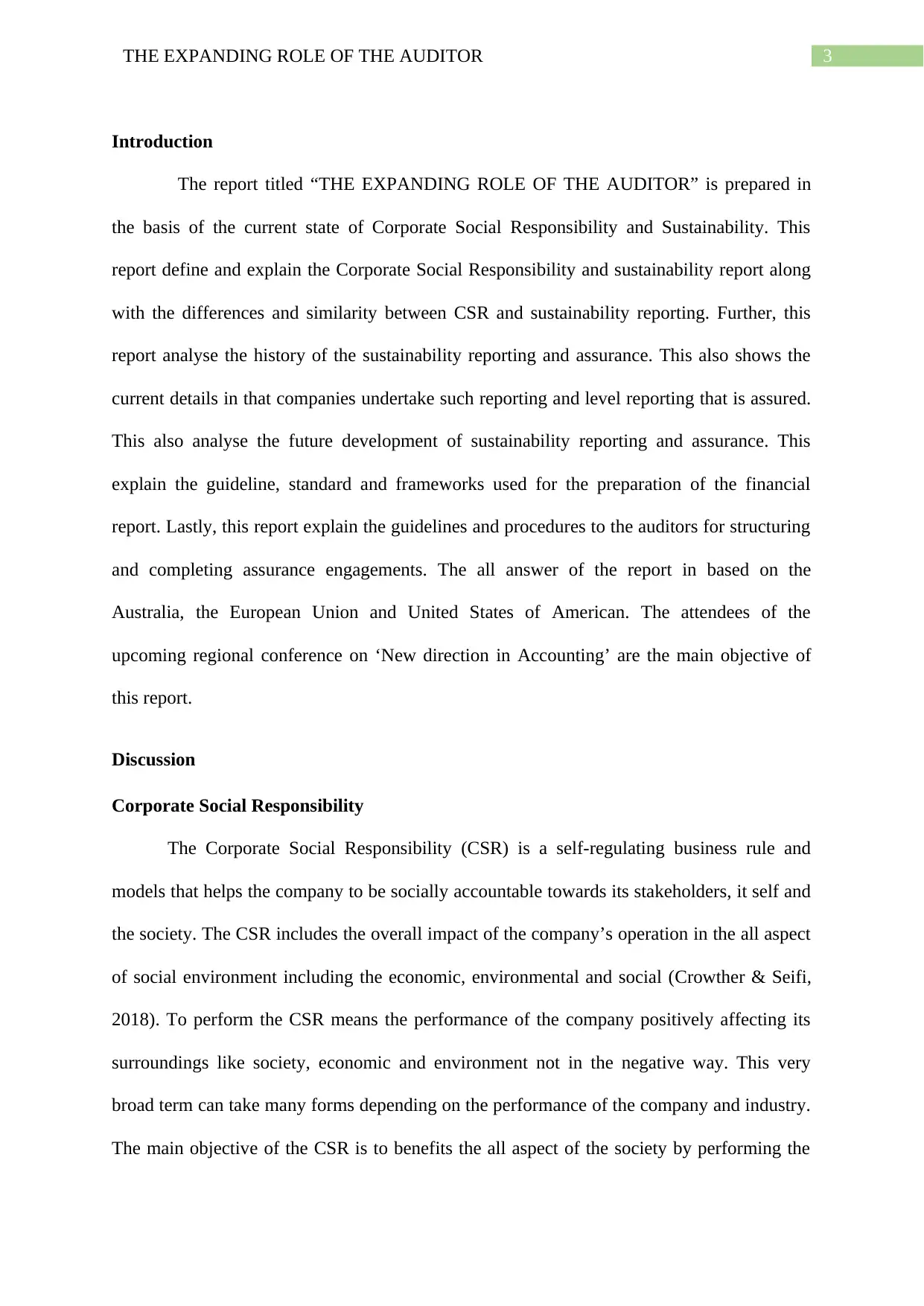
3THE EXPANDING ROLE OF THE AUDITOR
Introduction
The report titled “THE EXPANDING ROLE OF THE AUDITOR” is prepared in
the basis of the current state of Corporate Social Responsibility and Sustainability. This
report define and explain the Corporate Social Responsibility and sustainability report along
with the differences and similarity between CSR and sustainability reporting. Further, this
report analyse the history of the sustainability reporting and assurance. This also shows the
current details in that companies undertake such reporting and level reporting that is assured.
This also analyse the future development of sustainability reporting and assurance. This
explain the guideline, standard and frameworks used for the preparation of the financial
report. Lastly, this report explain the guidelines and procedures to the auditors for structuring
and completing assurance engagements. The all answer of the report in based on the
Australia, the European Union and United States of American. The attendees of the
upcoming regional conference on ‘New direction in Accounting’ are the main objective of
this report.
Discussion
Corporate Social Responsibility
The Corporate Social Responsibility (CSR) is a self-regulating business rule and
models that helps the company to be socially accountable towards its stakeholders, it self and
the society. The CSR includes the overall impact of the company’s operation in the all aspect
of social environment including the economic, environmental and social (Crowther & Seifi,
2018). To perform the CSR means the performance of the company positively affecting its
surroundings like society, economic and environment not in the negative way. This very
broad term can take many forms depending on the performance of the company and industry.
The main objective of the CSR is to benefits the all aspect of the society by performing the
Introduction
The report titled “THE EXPANDING ROLE OF THE AUDITOR” is prepared in
the basis of the current state of Corporate Social Responsibility and Sustainability. This
report define and explain the Corporate Social Responsibility and sustainability report along
with the differences and similarity between CSR and sustainability reporting. Further, this
report analyse the history of the sustainability reporting and assurance. This also shows the
current details in that companies undertake such reporting and level reporting that is assured.
This also analyse the future development of sustainability reporting and assurance. This
explain the guideline, standard and frameworks used for the preparation of the financial
report. Lastly, this report explain the guidelines and procedures to the auditors for structuring
and completing assurance engagements. The all answer of the report in based on the
Australia, the European Union and United States of American. The attendees of the
upcoming regional conference on ‘New direction in Accounting’ are the main objective of
this report.
Discussion
Corporate Social Responsibility
The Corporate Social Responsibility (CSR) is a self-regulating business rule and
models that helps the company to be socially accountable towards its stakeholders, it self and
the society. The CSR includes the overall impact of the company’s operation in the all aspect
of social environment including the economic, environmental and social (Crowther & Seifi,
2018). To perform the CSR means the performance of the company positively affecting its
surroundings like society, economic and environment not in the negative way. This very
broad term can take many forms depending on the performance of the company and industry.
The main objective of the CSR is to benefits the all aspect of the society by performing the
Paraphrase This Document
Need a fresh take? Get an instant paraphrase of this document with our AI Paraphraser
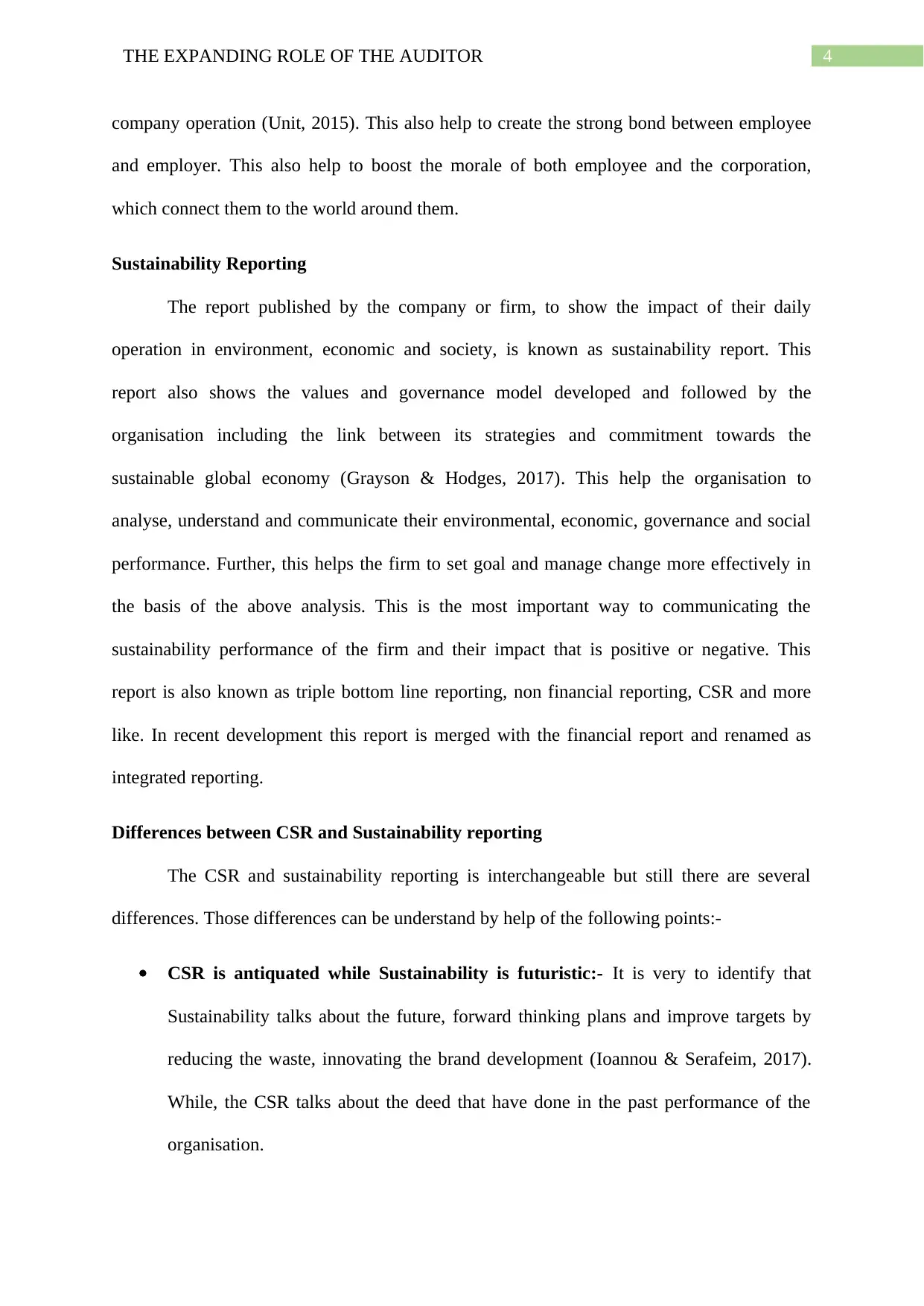
4THE EXPANDING ROLE OF THE AUDITOR
company operation (Unit, 2015). This also help to create the strong bond between employee
and employer. This also help to boost the morale of both employee and the corporation,
which connect them to the world around them.
Sustainability Reporting
The report published by the company or firm, to show the impact of their daily
operation in environment, economic and society, is known as sustainability report. This
report also shows the values and governance model developed and followed by the
organisation including the link between its strategies and commitment towards the
sustainable global economy (Grayson & Hodges, 2017). This help the organisation to
analyse, understand and communicate their environmental, economic, governance and social
performance. Further, this helps the firm to set goal and manage change more effectively in
the basis of the above analysis. This is the most important way to communicating the
sustainability performance of the firm and their impact that is positive or negative. This
report is also known as triple bottom line reporting, non financial reporting, CSR and more
like. In recent development this report is merged with the financial report and renamed as
integrated reporting.
Differences between CSR and Sustainability reporting
The CSR and sustainability reporting is interchangeable but still there are several
differences. Those differences can be understand by help of the following points:-
CSR is antiquated while Sustainability is futuristic:- It is very to identify that
Sustainability talks about the future, forward thinking plans and improve targets by
reducing the waste, innovating the brand development (Ioannou & Serafeim, 2017).
While, the CSR talks about the deed that have done in the past performance of the
organisation.
company operation (Unit, 2015). This also help to create the strong bond between employee
and employer. This also help to boost the morale of both employee and the corporation,
which connect them to the world around them.
Sustainability Reporting
The report published by the company or firm, to show the impact of their daily
operation in environment, economic and society, is known as sustainability report. This
report also shows the values and governance model developed and followed by the
organisation including the link between its strategies and commitment towards the
sustainable global economy (Grayson & Hodges, 2017). This help the organisation to
analyse, understand and communicate their environmental, economic, governance and social
performance. Further, this helps the firm to set goal and manage change more effectively in
the basis of the above analysis. This is the most important way to communicating the
sustainability performance of the firm and their impact that is positive or negative. This
report is also known as triple bottom line reporting, non financial reporting, CSR and more
like. In recent development this report is merged with the financial report and renamed as
integrated reporting.
Differences between CSR and Sustainability reporting
The CSR and sustainability reporting is interchangeable but still there are several
differences. Those differences can be understand by help of the following points:-
CSR is antiquated while Sustainability is futuristic:- It is very to identify that
Sustainability talks about the future, forward thinking plans and improve targets by
reducing the waste, innovating the brand development (Ioannou & Serafeim, 2017).
While, the CSR talks about the deed that have done in the past performance of the
organisation.
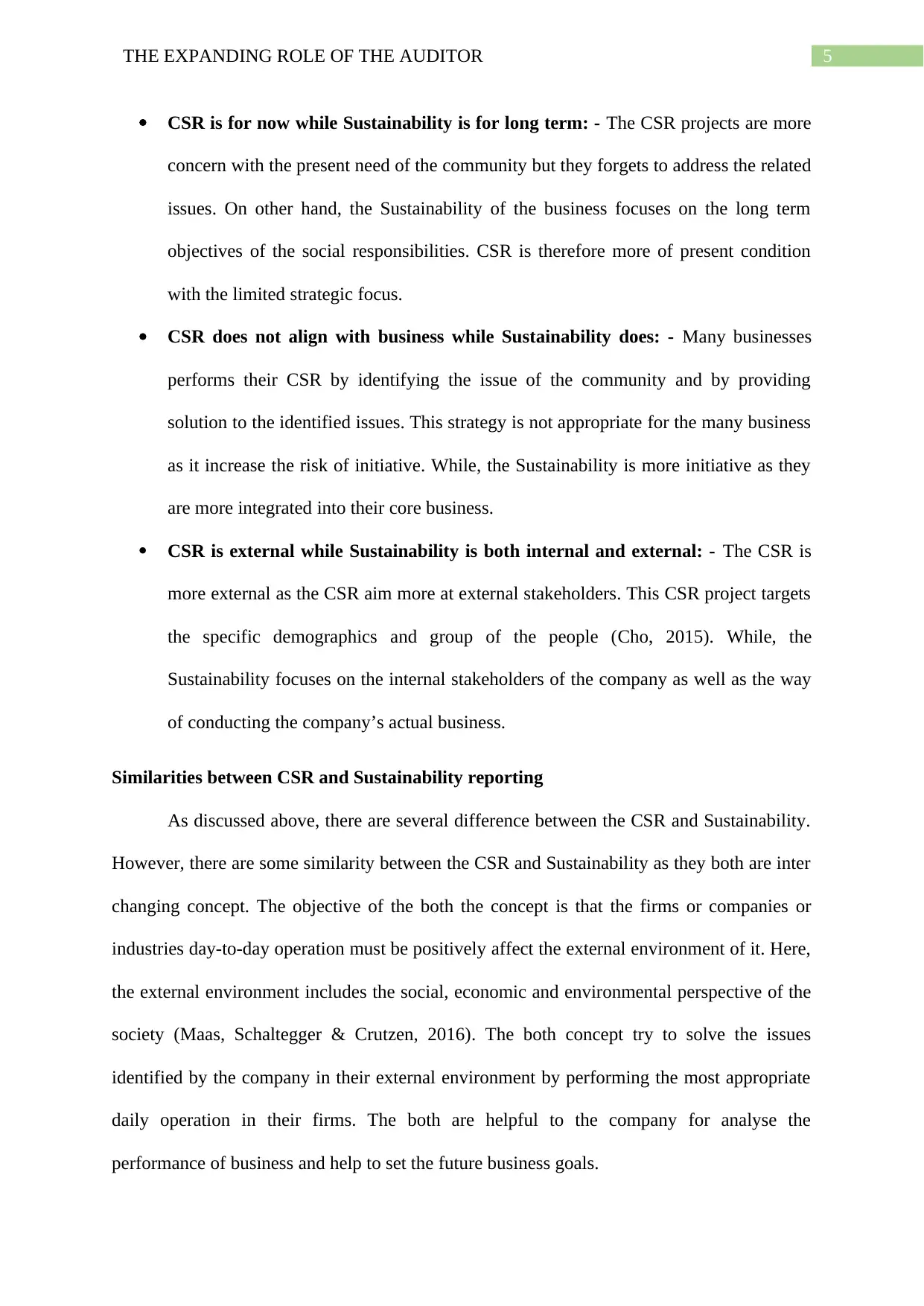
5THE EXPANDING ROLE OF THE AUDITOR
CSR is for now while Sustainability is for long term: - The CSR projects are more
concern with the present need of the community but they forgets to address the related
issues. On other hand, the Sustainability of the business focuses on the long term
objectives of the social responsibilities. CSR is therefore more of present condition
with the limited strategic focus.
CSR does not align with business while Sustainability does: - Many businesses
performs their CSR by identifying the issue of the community and by providing
solution to the identified issues. This strategy is not appropriate for the many business
as it increase the risk of initiative. While, the Sustainability is more initiative as they
are more integrated into their core business.
CSR is external while Sustainability is both internal and external: - The CSR is
more external as the CSR aim more at external stakeholders. This CSR project targets
the specific demographics and group of the people (Cho, 2015). While, the
Sustainability focuses on the internal stakeholders of the company as well as the way
of conducting the company’s actual business.
Similarities between CSR and Sustainability reporting
As discussed above, there are several difference between the CSR and Sustainability.
However, there are some similarity between the CSR and Sustainability as they both are inter
changing concept. The objective of the both the concept is that the firms or companies or
industries day-to-day operation must be positively affect the external environment of it. Here,
the external environment includes the social, economic and environmental perspective of the
society (Maas, Schaltegger & Crutzen, 2016). The both concept try to solve the issues
identified by the company in their external environment by performing the most appropriate
daily operation in their firms. The both are helpful to the company for analyse the
performance of business and help to set the future business goals.
CSR is for now while Sustainability is for long term: - The CSR projects are more
concern with the present need of the community but they forgets to address the related
issues. On other hand, the Sustainability of the business focuses on the long term
objectives of the social responsibilities. CSR is therefore more of present condition
with the limited strategic focus.
CSR does not align with business while Sustainability does: - Many businesses
performs their CSR by identifying the issue of the community and by providing
solution to the identified issues. This strategy is not appropriate for the many business
as it increase the risk of initiative. While, the Sustainability is more initiative as they
are more integrated into their core business.
CSR is external while Sustainability is both internal and external: - The CSR is
more external as the CSR aim more at external stakeholders. This CSR project targets
the specific demographics and group of the people (Cho, 2015). While, the
Sustainability focuses on the internal stakeholders of the company as well as the way
of conducting the company’s actual business.
Similarities between CSR and Sustainability reporting
As discussed above, there are several difference between the CSR and Sustainability.
However, there are some similarity between the CSR and Sustainability as they both are inter
changing concept. The objective of the both the concept is that the firms or companies or
industries day-to-day operation must be positively affect the external environment of it. Here,
the external environment includes the social, economic and environmental perspective of the
society (Maas, Schaltegger & Crutzen, 2016). The both concept try to solve the issues
identified by the company in their external environment by performing the most appropriate
daily operation in their firms. The both are helpful to the company for analyse the
performance of business and help to set the future business goals.
⊘ This is a preview!⊘
Do you want full access?
Subscribe today to unlock all pages.

Trusted by 1+ million students worldwide
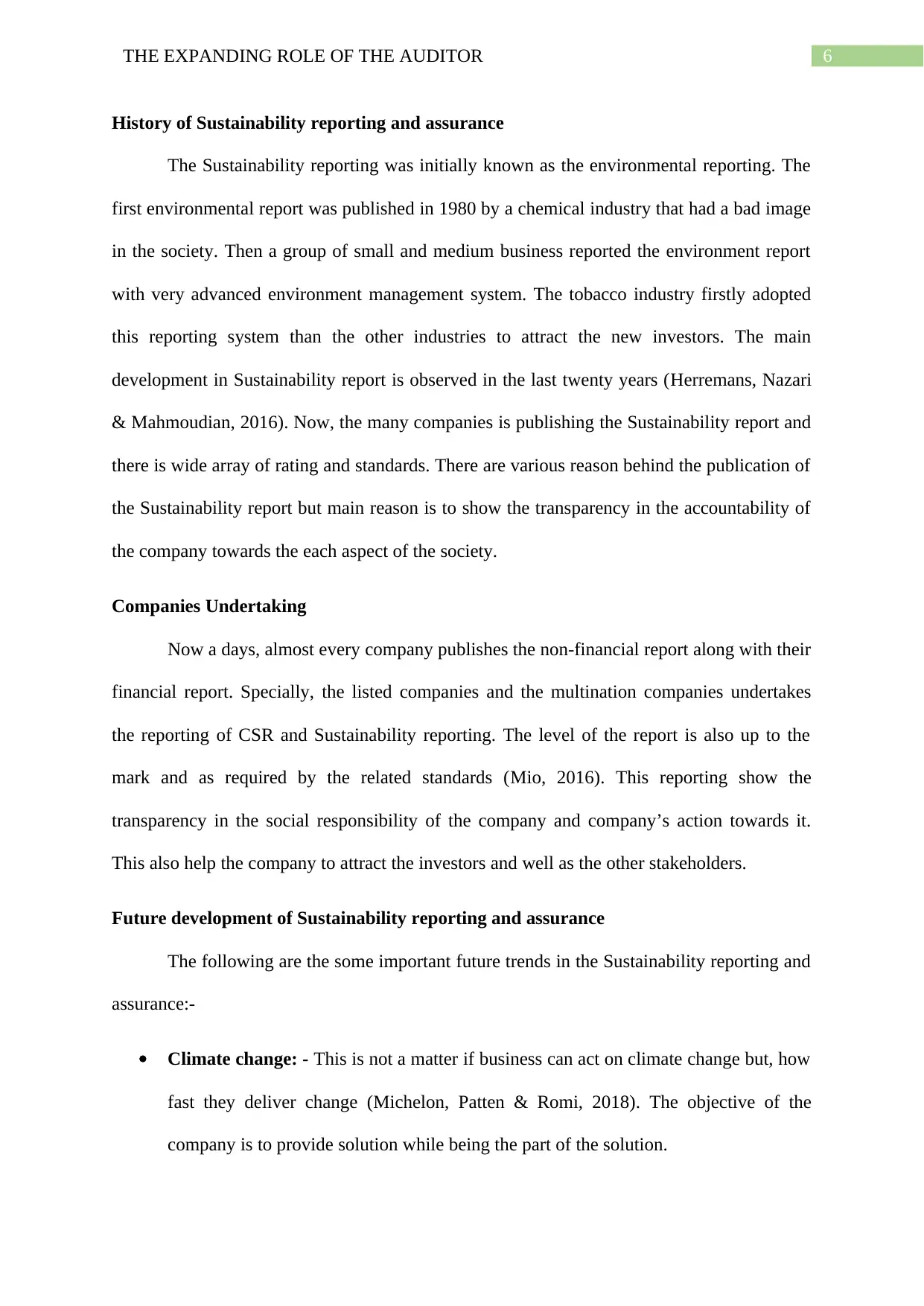
6THE EXPANDING ROLE OF THE AUDITOR
History of Sustainability reporting and assurance
The Sustainability reporting was initially known as the environmental reporting. The
first environmental report was published in 1980 by a chemical industry that had a bad image
in the society. Then a group of small and medium business reported the environment report
with very advanced environment management system. The tobacco industry firstly adopted
this reporting system than the other industries to attract the new investors. The main
development in Sustainability report is observed in the last twenty years (Herremans, Nazari
& Mahmoudian, 2016). Now, the many companies is publishing the Sustainability report and
there is wide array of rating and standards. There are various reason behind the publication of
the Sustainability report but main reason is to show the transparency in the accountability of
the company towards the each aspect of the society.
Companies Undertaking
Now a days, almost every company publishes the non-financial report along with their
financial report. Specially, the listed companies and the multination companies undertakes
the reporting of CSR and Sustainability reporting. The level of the report is also up to the
mark and as required by the related standards (Mio, 2016). This reporting show the
transparency in the social responsibility of the company and company’s action towards it.
This also help the company to attract the investors and well as the other stakeholders.
Future development of Sustainability reporting and assurance
The following are the some important future trends in the Sustainability reporting and
assurance:-
Climate change: - This is not a matter if business can act on climate change but, how
fast they deliver change (Michelon, Patten & Romi, 2018). The objective of the
company is to provide solution while being the part of the solution.
History of Sustainability reporting and assurance
The Sustainability reporting was initially known as the environmental reporting. The
first environmental report was published in 1980 by a chemical industry that had a bad image
in the society. Then a group of small and medium business reported the environment report
with very advanced environment management system. The tobacco industry firstly adopted
this reporting system than the other industries to attract the new investors. The main
development in Sustainability report is observed in the last twenty years (Herremans, Nazari
& Mahmoudian, 2016). Now, the many companies is publishing the Sustainability report and
there is wide array of rating and standards. There are various reason behind the publication of
the Sustainability report but main reason is to show the transparency in the accountability of
the company towards the each aspect of the society.
Companies Undertaking
Now a days, almost every company publishes the non-financial report along with their
financial report. Specially, the listed companies and the multination companies undertakes
the reporting of CSR and Sustainability reporting. The level of the report is also up to the
mark and as required by the related standards (Mio, 2016). This reporting show the
transparency in the social responsibility of the company and company’s action towards it.
This also help the company to attract the investors and well as the other stakeholders.
Future development of Sustainability reporting and assurance
The following are the some important future trends in the Sustainability reporting and
assurance:-
Climate change: - This is not a matter if business can act on climate change but, how
fast they deliver change (Michelon, Patten & Romi, 2018). The objective of the
company is to provide solution while being the part of the solution.
Paraphrase This Document
Need a fresh take? Get an instant paraphrase of this document with our AI Paraphraser
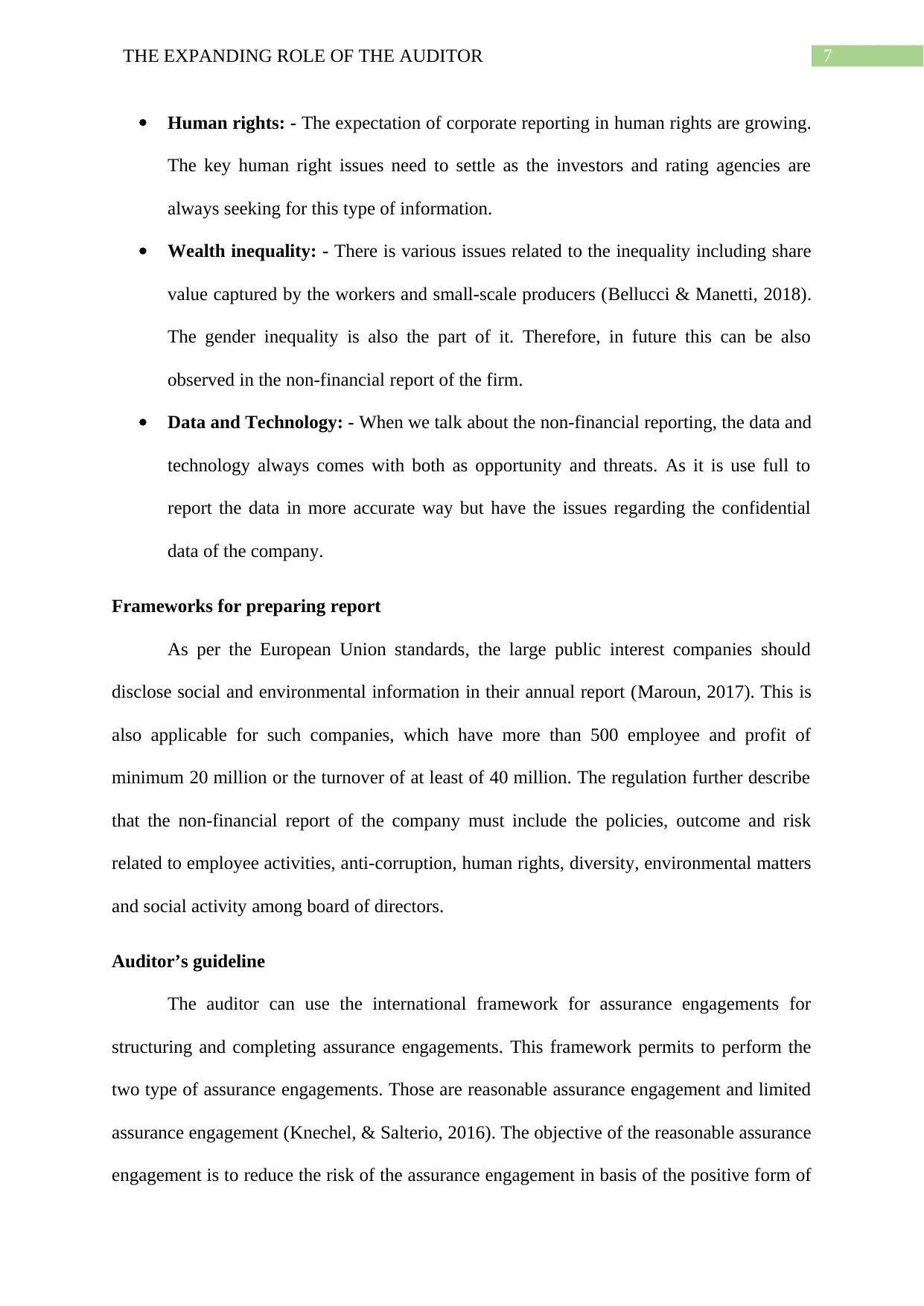
7THE EXPANDING ROLE OF THE AUDITOR
Human rights: - The expectation of corporate reporting in human rights are growing.
The key human right issues need to settle as the investors and rating agencies are
always seeking for this type of information.
Wealth inequality: - There is various issues related to the inequality including share
value captured by the workers and small-scale producers (Bellucci & Manetti, 2018).
The gender inequality is also the part of it. Therefore, in future this can be also
observed in the non-financial report of the firm.
Data and Technology: - When we talk about the non-financial reporting, the data and
technology always comes with both as opportunity and threats. As it is use full to
report the data in more accurate way but have the issues regarding the confidential
data of the company.
Frameworks for preparing report
As per the European Union standards, the large public interest companies should
disclose social and environmental information in their annual report (Maroun, 2017). This is
also applicable for such companies, which have more than 500 employee and profit of
minimum 20 million or the turnover of at least of 40 million. The regulation further describe
that the non-financial report of the company must include the policies, outcome and risk
related to employee activities, anti-corruption, human rights, diversity, environmental matters
and social activity among board of directors.
Auditor’s guideline
The auditor can use the international framework for assurance engagements for
structuring and completing assurance engagements. This framework permits to perform the
two type of assurance engagements. Those are reasonable assurance engagement and limited
assurance engagement (Knechel, & Salterio, 2016). The objective of the reasonable assurance
engagement is to reduce the risk of the assurance engagement in basis of the positive form of
Human rights: - The expectation of corporate reporting in human rights are growing.
The key human right issues need to settle as the investors and rating agencies are
always seeking for this type of information.
Wealth inequality: - There is various issues related to the inequality including share
value captured by the workers and small-scale producers (Bellucci & Manetti, 2018).
The gender inequality is also the part of it. Therefore, in future this can be also
observed in the non-financial report of the firm.
Data and Technology: - When we talk about the non-financial reporting, the data and
technology always comes with both as opportunity and threats. As it is use full to
report the data in more accurate way but have the issues regarding the confidential
data of the company.
Frameworks for preparing report
As per the European Union standards, the large public interest companies should
disclose social and environmental information in their annual report (Maroun, 2017). This is
also applicable for such companies, which have more than 500 employee and profit of
minimum 20 million or the turnover of at least of 40 million. The regulation further describe
that the non-financial report of the company must include the policies, outcome and risk
related to employee activities, anti-corruption, human rights, diversity, environmental matters
and social activity among board of directors.
Auditor’s guideline
The auditor can use the international framework for assurance engagements for
structuring and completing assurance engagements. This framework permits to perform the
two type of assurance engagements. Those are reasonable assurance engagement and limited
assurance engagement (Knechel, & Salterio, 2016). The objective of the reasonable assurance
engagement is to reduce the risk of the assurance engagement in basis of the positive form of
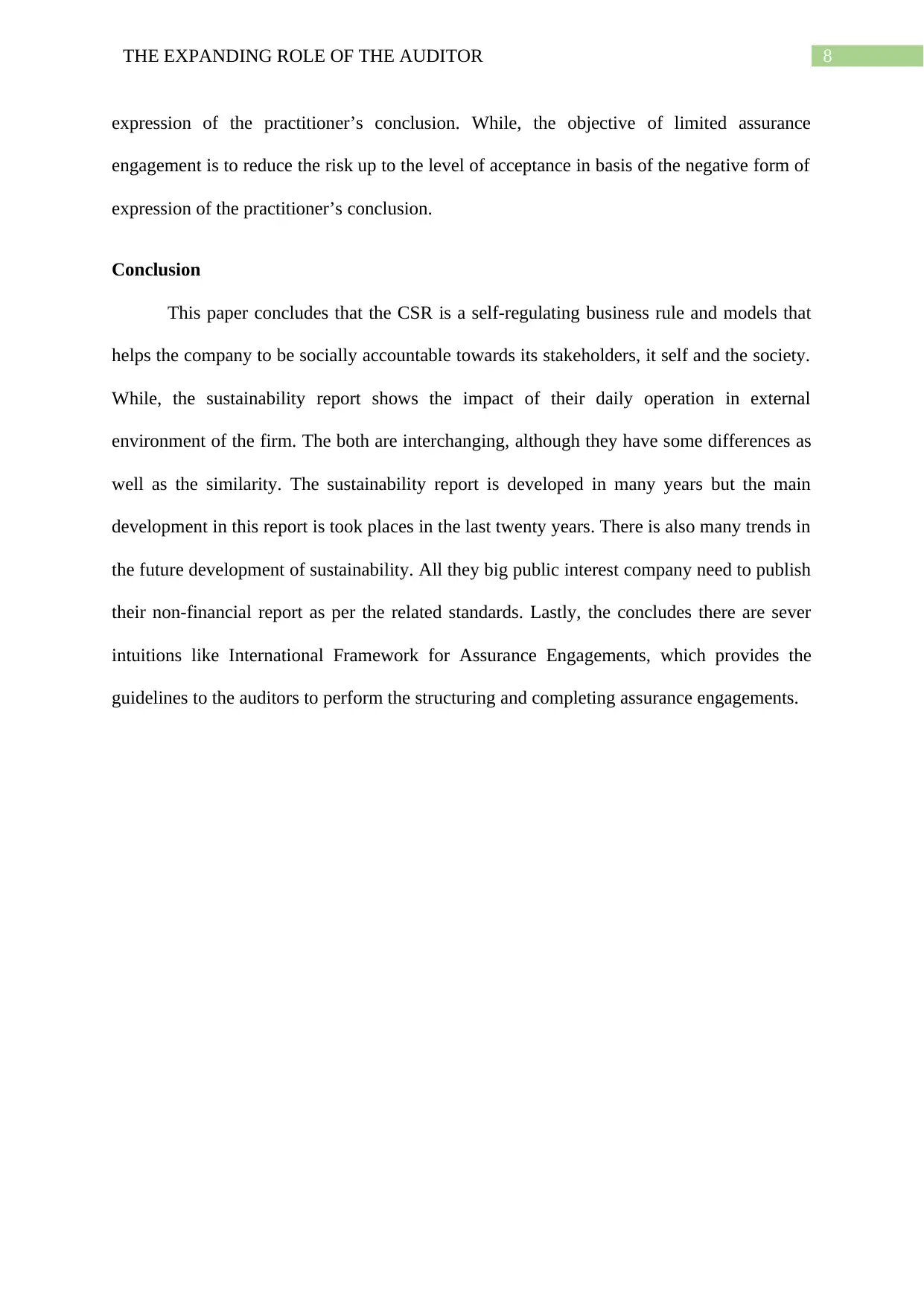
8THE EXPANDING ROLE OF THE AUDITOR
expression of the practitioner’s conclusion. While, the objective of limited assurance
engagement is to reduce the risk up to the level of acceptance in basis of the negative form of
expression of the practitioner’s conclusion.
Conclusion
This paper concludes that the CSR is a self-regulating business rule and models that
helps the company to be socially accountable towards its stakeholders, it self and the society.
While, the sustainability report shows the impact of their daily operation in external
environment of the firm. The both are interchanging, although they have some differences as
well as the similarity. The sustainability report is developed in many years but the main
development in this report is took places in the last twenty years. There is also many trends in
the future development of sustainability. All they big public interest company need to publish
their non-financial report as per the related standards. Lastly, the concludes there are sever
intuitions like International Framework for Assurance Engagements, which provides the
guidelines to the auditors to perform the structuring and completing assurance engagements.
expression of the practitioner’s conclusion. While, the objective of limited assurance
engagement is to reduce the risk up to the level of acceptance in basis of the negative form of
expression of the practitioner’s conclusion.
Conclusion
This paper concludes that the CSR is a self-regulating business rule and models that
helps the company to be socially accountable towards its stakeholders, it self and the society.
While, the sustainability report shows the impact of their daily operation in external
environment of the firm. The both are interchanging, although they have some differences as
well as the similarity. The sustainability report is developed in many years but the main
development in this report is took places in the last twenty years. There is also many trends in
the future development of sustainability. All they big public interest company need to publish
their non-financial report as per the related standards. Lastly, the concludes there are sever
intuitions like International Framework for Assurance Engagements, which provides the
guidelines to the auditors to perform the structuring and completing assurance engagements.
⊘ This is a preview!⊘
Do you want full access?
Subscribe today to unlock all pages.

Trusted by 1+ million students worldwide
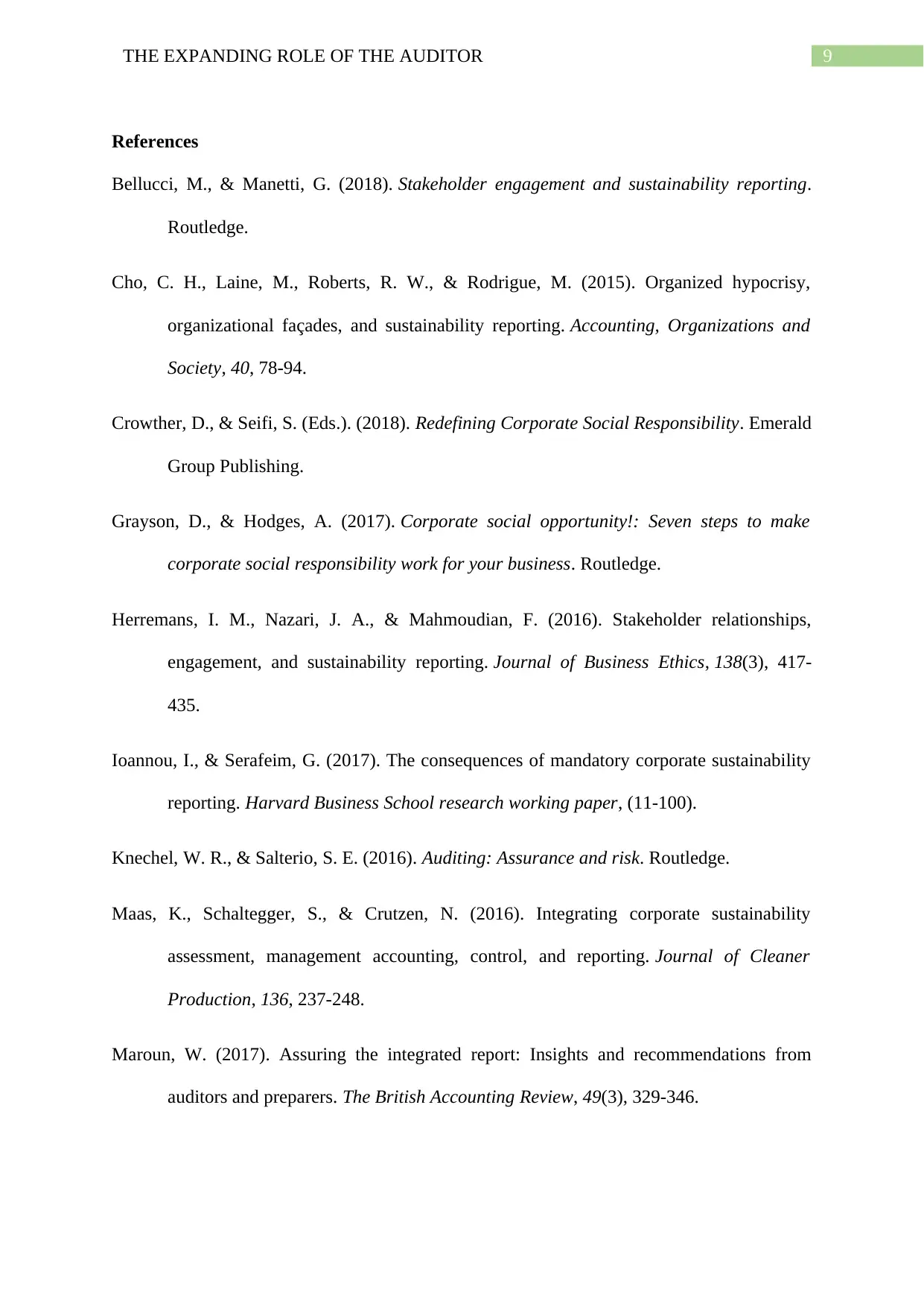
9THE EXPANDING ROLE OF THE AUDITOR
References
Bellucci, M., & Manetti, G. (2018). Stakeholder engagement and sustainability reporting.
Routledge.
Cho, C. H., Laine, M., Roberts, R. W., & Rodrigue, M. (2015). Organized hypocrisy,
organizational façades, and sustainability reporting. Accounting, Organizations and
Society, 40, 78-94.
Crowther, D., & Seifi, S. (Eds.). (2018). Redefining Corporate Social Responsibility. Emerald
Group Publishing.
Grayson, D., & Hodges, A. (2017). Corporate social opportunity!: Seven steps to make
corporate social responsibility work for your business. Routledge.
Herremans, I. M., Nazari, J. A., & Mahmoudian, F. (2016). Stakeholder relationships,
engagement, and sustainability reporting. Journal of Business Ethics, 138(3), 417-
435.
Ioannou, I., & Serafeim, G. (2017). The consequences of mandatory corporate sustainability
reporting. Harvard Business School research working paper, (11-100).
Knechel, W. R., & Salterio, S. E. (2016). Auditing: Assurance and risk. Routledge.
Maas, K., Schaltegger, S., & Crutzen, N. (2016). Integrating corporate sustainability
assessment, management accounting, control, and reporting. Journal of Cleaner
Production, 136, 237-248.
Maroun, W. (2017). Assuring the integrated report: Insights and recommendations from
auditors and preparers. The British Accounting Review, 49(3), 329-346.
References
Bellucci, M., & Manetti, G. (2018). Stakeholder engagement and sustainability reporting.
Routledge.
Cho, C. H., Laine, M., Roberts, R. W., & Rodrigue, M. (2015). Organized hypocrisy,
organizational façades, and sustainability reporting. Accounting, Organizations and
Society, 40, 78-94.
Crowther, D., & Seifi, S. (Eds.). (2018). Redefining Corporate Social Responsibility. Emerald
Group Publishing.
Grayson, D., & Hodges, A. (2017). Corporate social opportunity!: Seven steps to make
corporate social responsibility work for your business. Routledge.
Herremans, I. M., Nazari, J. A., & Mahmoudian, F. (2016). Stakeholder relationships,
engagement, and sustainability reporting. Journal of Business Ethics, 138(3), 417-
435.
Ioannou, I., & Serafeim, G. (2017). The consequences of mandatory corporate sustainability
reporting. Harvard Business School research working paper, (11-100).
Knechel, W. R., & Salterio, S. E. (2016). Auditing: Assurance and risk. Routledge.
Maas, K., Schaltegger, S., & Crutzen, N. (2016). Integrating corporate sustainability
assessment, management accounting, control, and reporting. Journal of Cleaner
Production, 136, 237-248.
Maroun, W. (2017). Assuring the integrated report: Insights and recommendations from
auditors and preparers. The British Accounting Review, 49(3), 329-346.
Paraphrase This Document
Need a fresh take? Get an instant paraphrase of this document with our AI Paraphraser
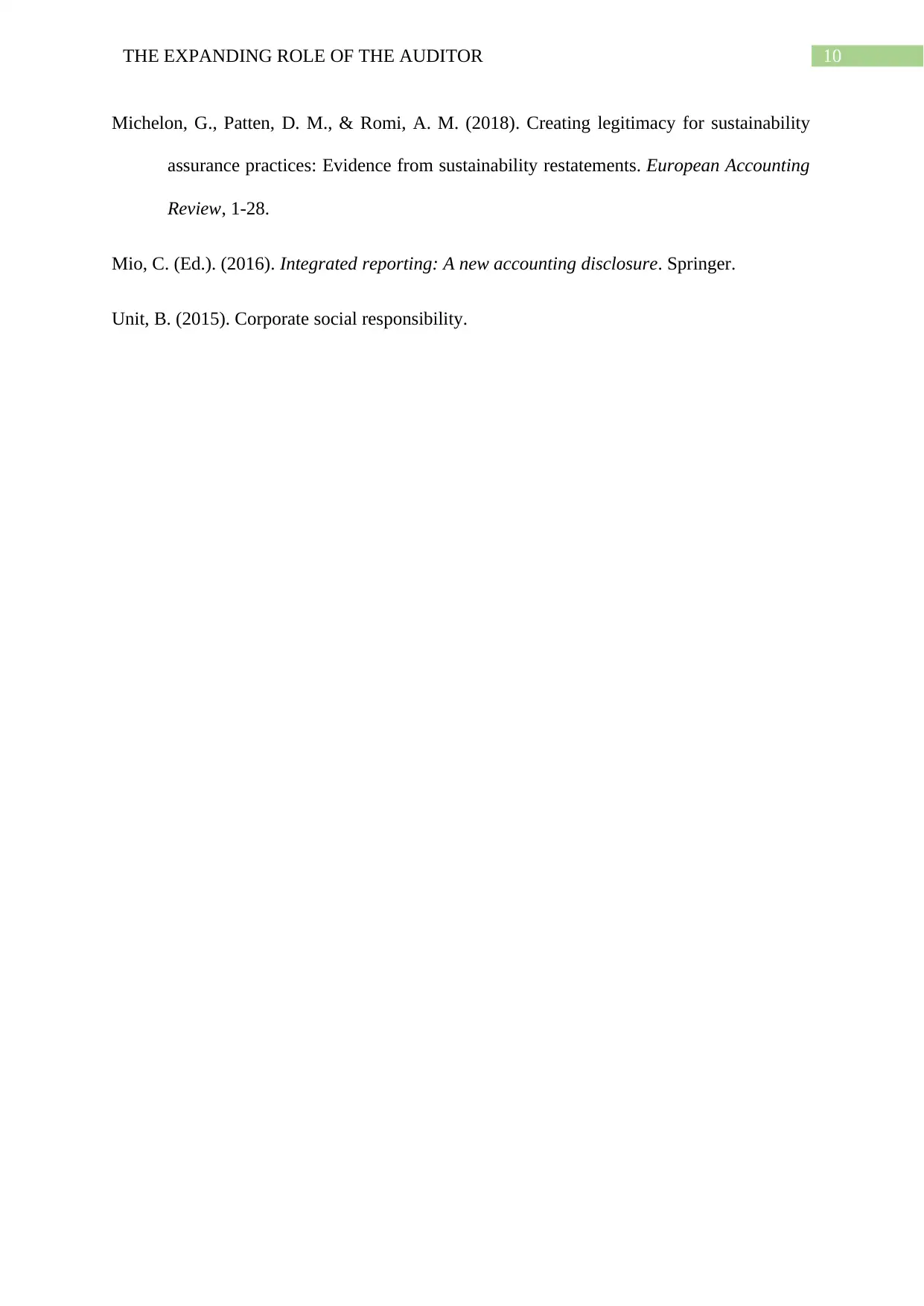
10THE EXPANDING ROLE OF THE AUDITOR
Michelon, G., Patten, D. M., & Romi, A. M. (2018). Creating legitimacy for sustainability
assurance practices: Evidence from sustainability restatements. European Accounting
Review, 1-28.
Mio, C. (Ed.). (2016). Integrated reporting: A new accounting disclosure. Springer.
Unit, B. (2015). Corporate social responsibility.
Michelon, G., Patten, D. M., & Romi, A. M. (2018). Creating legitimacy for sustainability
assurance practices: Evidence from sustainability restatements. European Accounting
Review, 1-28.
Mio, C. (Ed.). (2016). Integrated reporting: A new accounting disclosure. Springer.
Unit, B. (2015). Corporate social responsibility.
1 out of 11
Related Documents
Your All-in-One AI-Powered Toolkit for Academic Success.
+13062052269
info@desklib.com
Available 24*7 on WhatsApp / Email
![[object Object]](/_next/static/media/star-bottom.7253800d.svg)
Unlock your academic potential
Copyright © 2020–2025 A2Z Services. All Rights Reserved. Developed and managed by ZUCOL.





